MicroEcon Chapter 9
1/64
There's no tags or description
Looks like no tags are added yet.
Name | Mastery | Learn | Test | Matching | Spaced |
|---|
No study sessions yet.
65 Terms
Recall Comparative Advantage
Produce what they are relatively good at.
Tasks where they have a lower opportunity cost than others.
Buy what they are relatively bad at.
Tasks where you have a higher opportunity cost than someone else.
Result →The economic pie gets bigger and there are gains from trade that leave the exchanging parties both better off! We can produce more together than we can apart!
Comparative Advantage and International Trade
Geographic borders are irrelevant when it comes to comparative advantage!
Comparative advantage is what drives international trade
Import
To buy goods or services from “foreign” sellers.
Export
To sell goods or services to “foreign” buyers
Example of importing and exporting
Singapore example:
Singapore imports all its beef from Brazil, Australia, the United States, and New Zealand.
Singapore is a small island country, only 281.3 square miles(not a lot of space to raise cattle).
Singapore’s biggest export is integrated circuits
Trade costs
The extra costs incurred as a result of buying or selling internationally, rather than domestically
Trade costs determine whether it’s worth buying or selling internationally
Scenarios of Trade Costs
Shipping costs and potential delays
Taxes paid to the U.S. government on imports
Taxes paid to the foreign government on exports
Hassle of language barriers
Hassle of different time zones
Dealing with foreign laws
Trade Cost Example
Shopping online for a new phone case:
You see a case you like being sold by a Chinese vendor.
You consider both the price and the trade costs as part of the marginal cost to determine whether the phone case is worth it.
The trade costs you consider include the following:
Shipping costs
Potential shipping delays
Extra taxes you will have to pay to both the United and Chinese governments
The equation for determining whether to IMPORT good
Foreign price + trade costs < domestic price
The foreign price needs to be far enough below the domestic prices that the foreign price is still cheaper even after trade costs are brought into consideration
Example on determining whether to import a good
Foreign price ($15) + trade costs ($7) < domestic price ($30)
The equation for determining whether to EXPORT good
Foreign price− trade costs > domestic price
The foreign price needs to be far enough above the domestic prices that the foreign price is still higher even after export-related trade costs are brought into consideration
Example on determining whether to export a good
Foreign price ($100) − trade costs ($30) > domestic price ($65)
High trade costs
High trade costs: Importing and exporting are more costly.
Result: International trade is less likely to be worthwhile than it would be if the buyer and seller were in the same country
Low trade costs
Importing and exporting are less costly.
Result: International trade is more likely to be worthwhile
Takeaway of Trade Costs within International Trade
Trade costs are the major determinant of the volume of international trade.
Examples:
Music now has very low trade costs (thank you, internet!), so there is a huge amount of international trade in music.
You likely don’t get your dental work done in another country because the associated trade costs are large (flying to another country, booking a hotel, taking multiple days off work, etc.)
Sources of comparative advantage
Abundant inputs
Specialized skills
Mass production
Abundant inputs
Take advantage of what you have, to get what you want
Sell what you have a lot of and buy what you don’t have much of
What are Abundant input determined by?
Geography, climate, and natural resources:
Canada has ample forests → export wood.
Saudi Arabia has ample oil → export gasoline.
People, businesses, and strategic investments:
America’s investment in higher education created an abundance of highly educated and skilled workers → export of new medicines, software, and planes.
Specialized skills
Unique skills, production methods, or expertise can lower your opportunity costs.
Even if two countries have similar inputs (land, labor, and capital), better production techniques in one country will lead to a comparative advantage
Examples of Specialized skills
Switzerland has great watchmakers.
France (and Wisconsin!) produces great cheese.
Americans make good movies
Mass production
Benefits of mass production (sometimes called economies of scale):
Incredibly specialized production lines
Bargaining power
Examples of Mass production
Ikea Example:
Ikea created highly specialized production lines—robots that can work 24 hours a day, 7 days a week.
One of the world’s largest purchasers of wood.Uses this bargaining power to negotiate cheaper wood prices, further lowering its input costs.
World supply
The total quantity of a good supplied by all manufacturers around the world, at each price
World demand
The total quantity of a good demand by all buyers around the world, at each price
World price
The price that a product sells for in the global market.
World supply Example
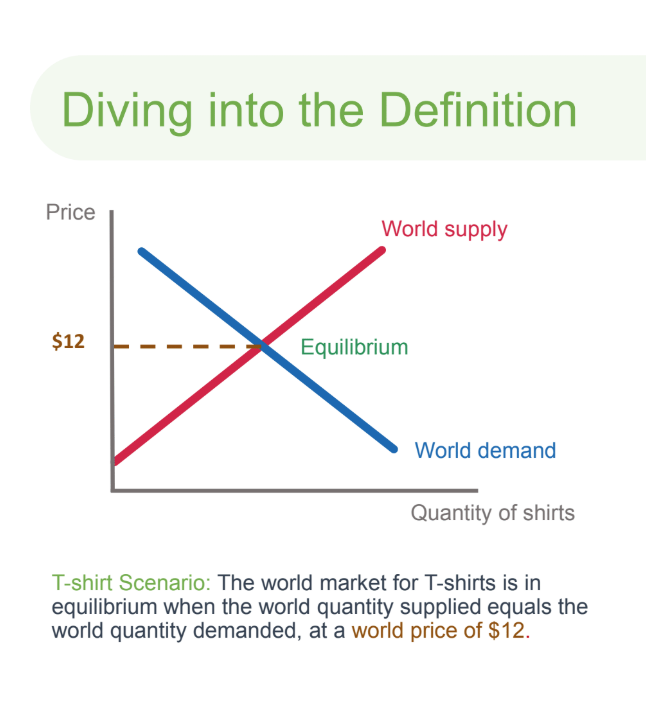
The Domestic Market
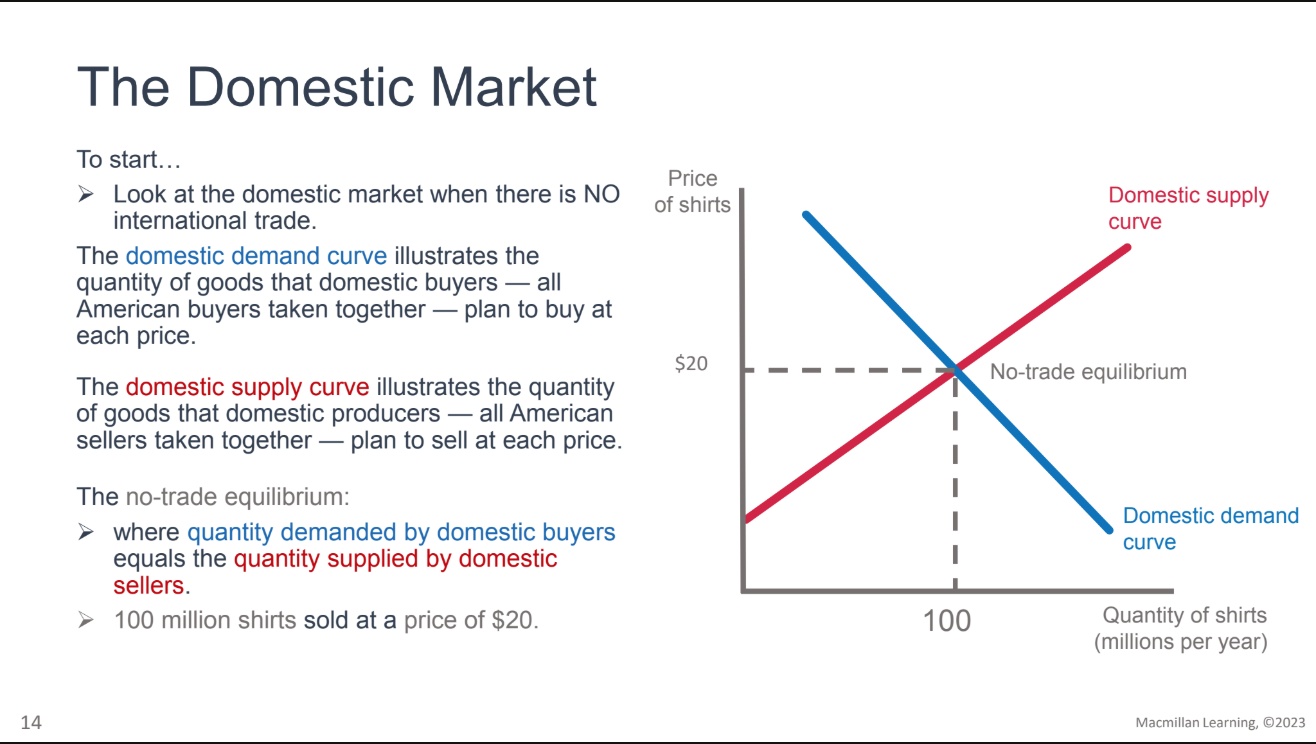
How to evaluate the effects of trade (Import and Export)
Figure out the new price
Determine the quantities demanded and supplied by the domestic buyers at this new price
Assess the quantity that will be traded
Example of evaluating the effects of Imports on the market
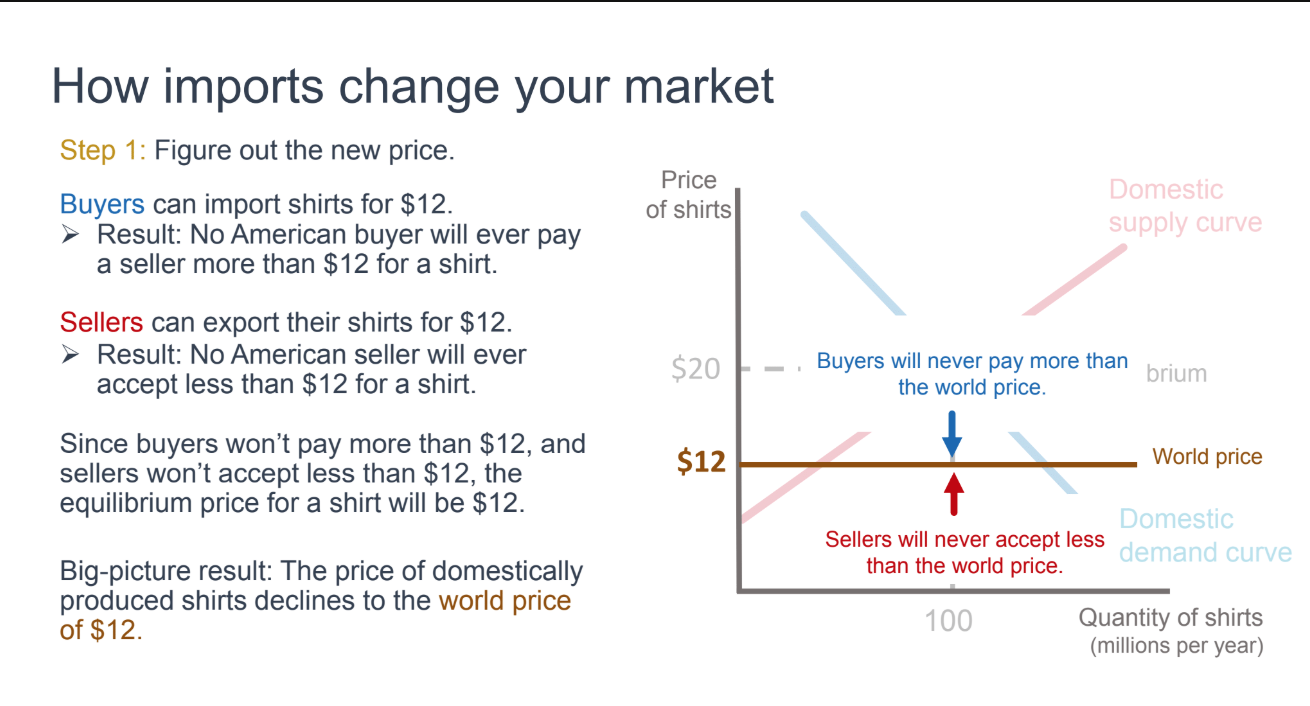

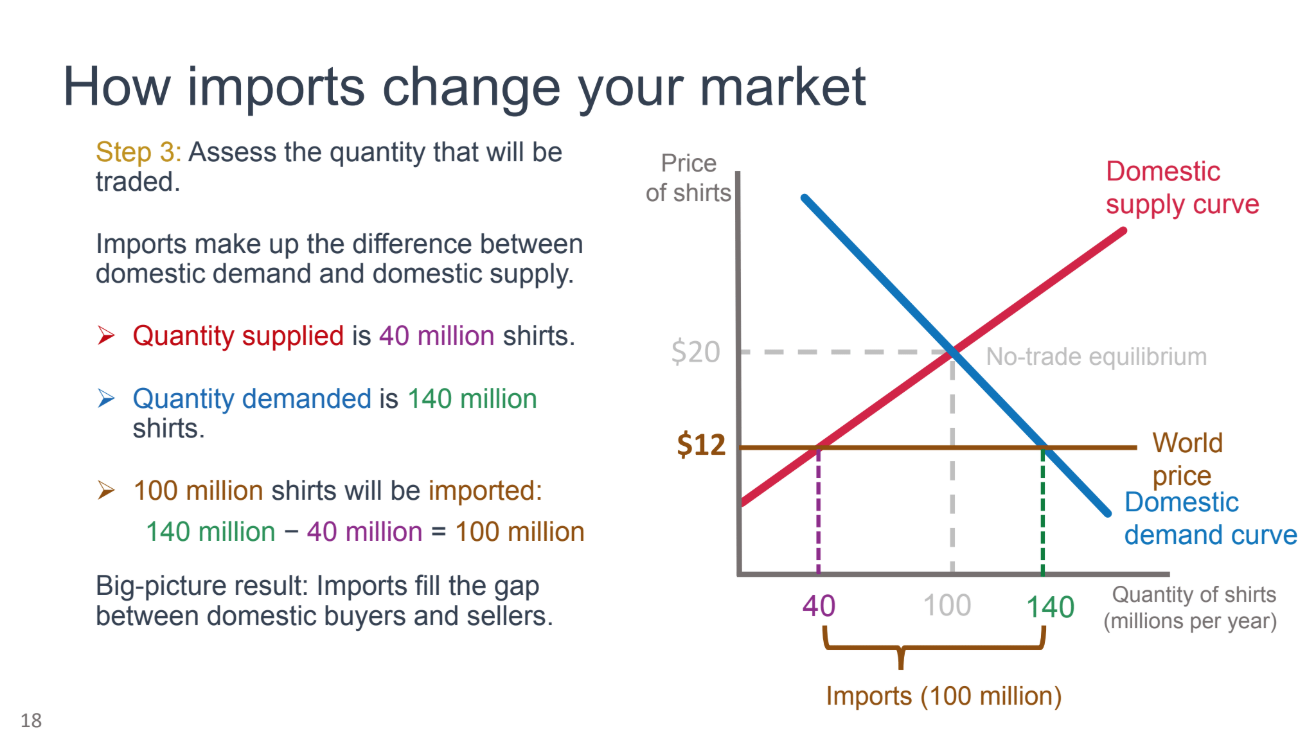
How to Analyzing the consequences of imports
No trade: What are consumer and producer surplus?
Free trade: What are the new consumer and producer surplus?
Evaluate the difference.
Visual representation of how imports raise economic surplus: No trade

Visual representation of how imports raise economic surplus: Free trade

Visual representation of how imports raise economic surplus: Evaluate the difference

Example of evaluating the effects of Exports on the market

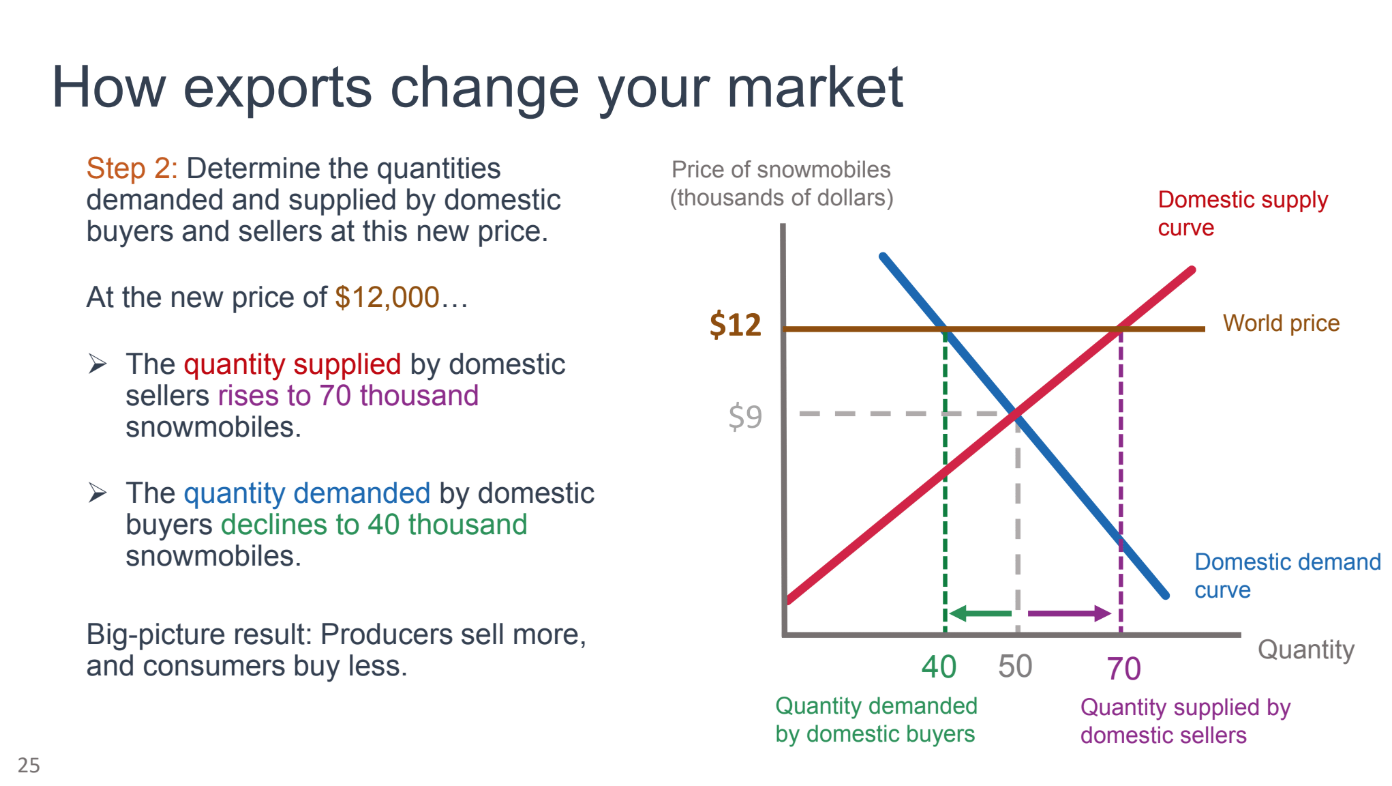
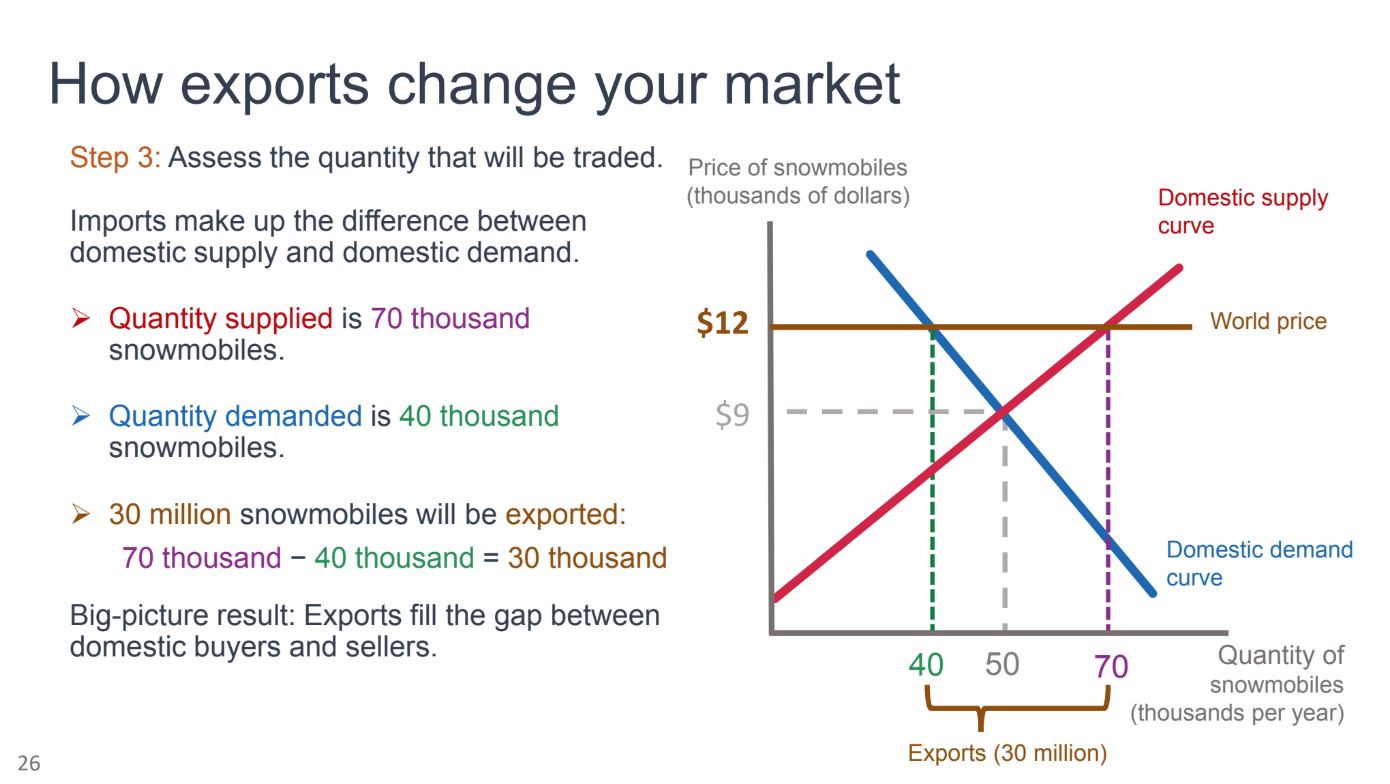
Visual representation of how Exports raise economic surplus: No trade
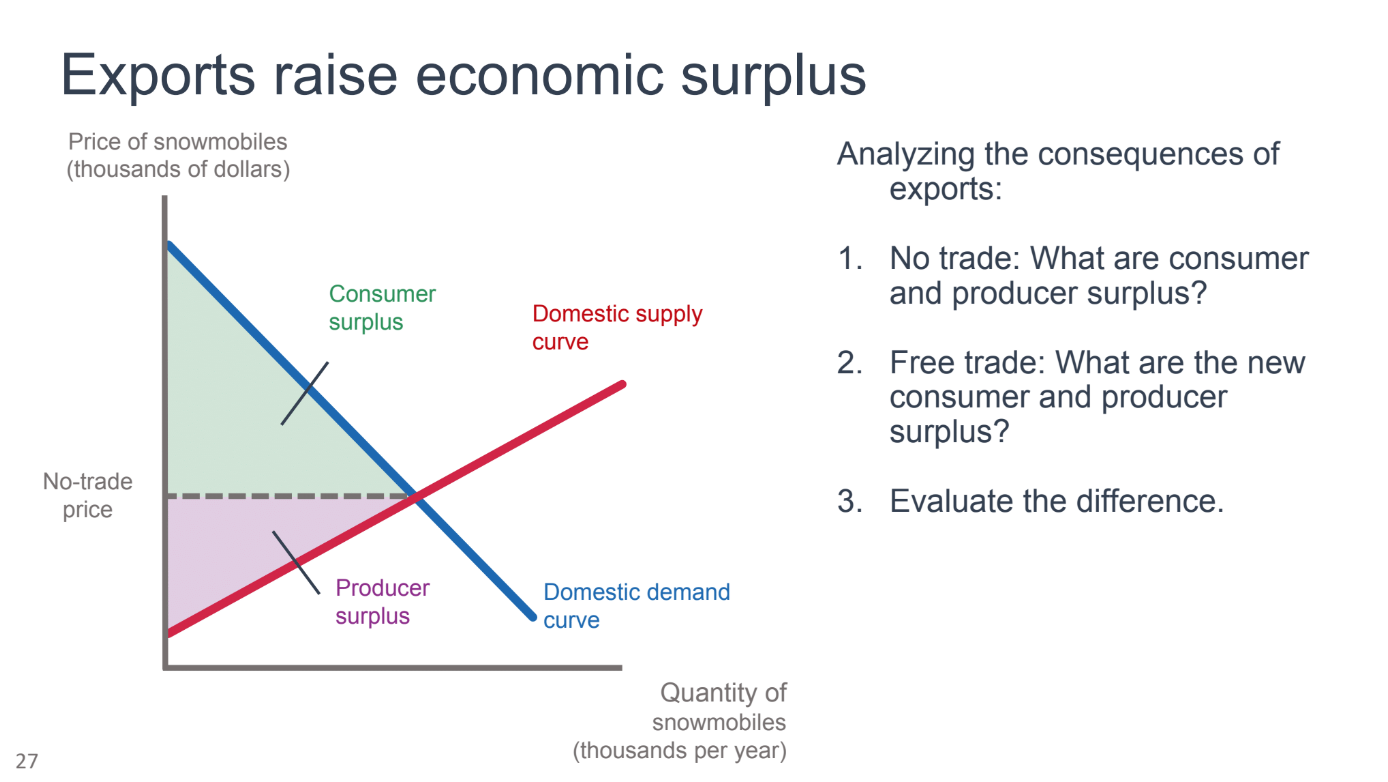
Visual representation of how Exports raise economic surplus: Free trade
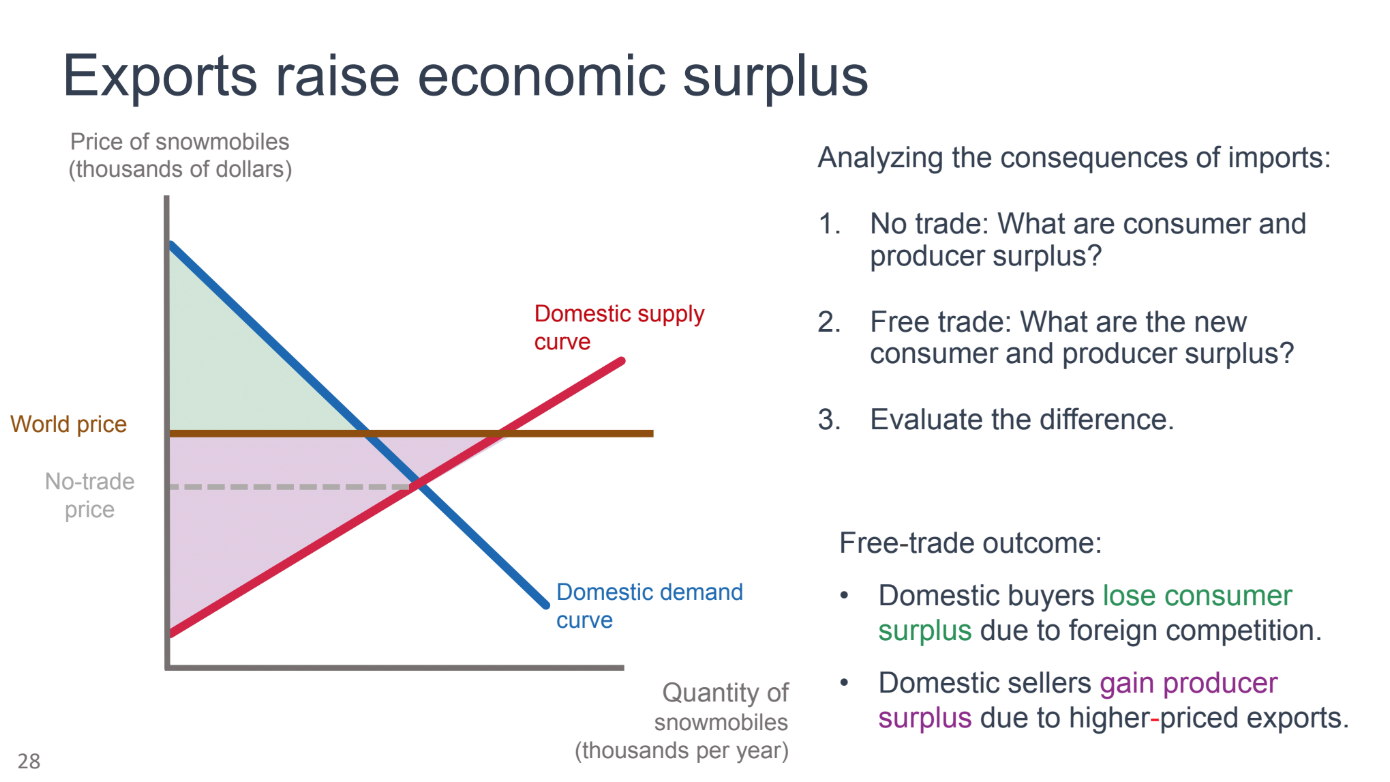
Visual representation of how Exports raise economic surplus: Evaluate the difference
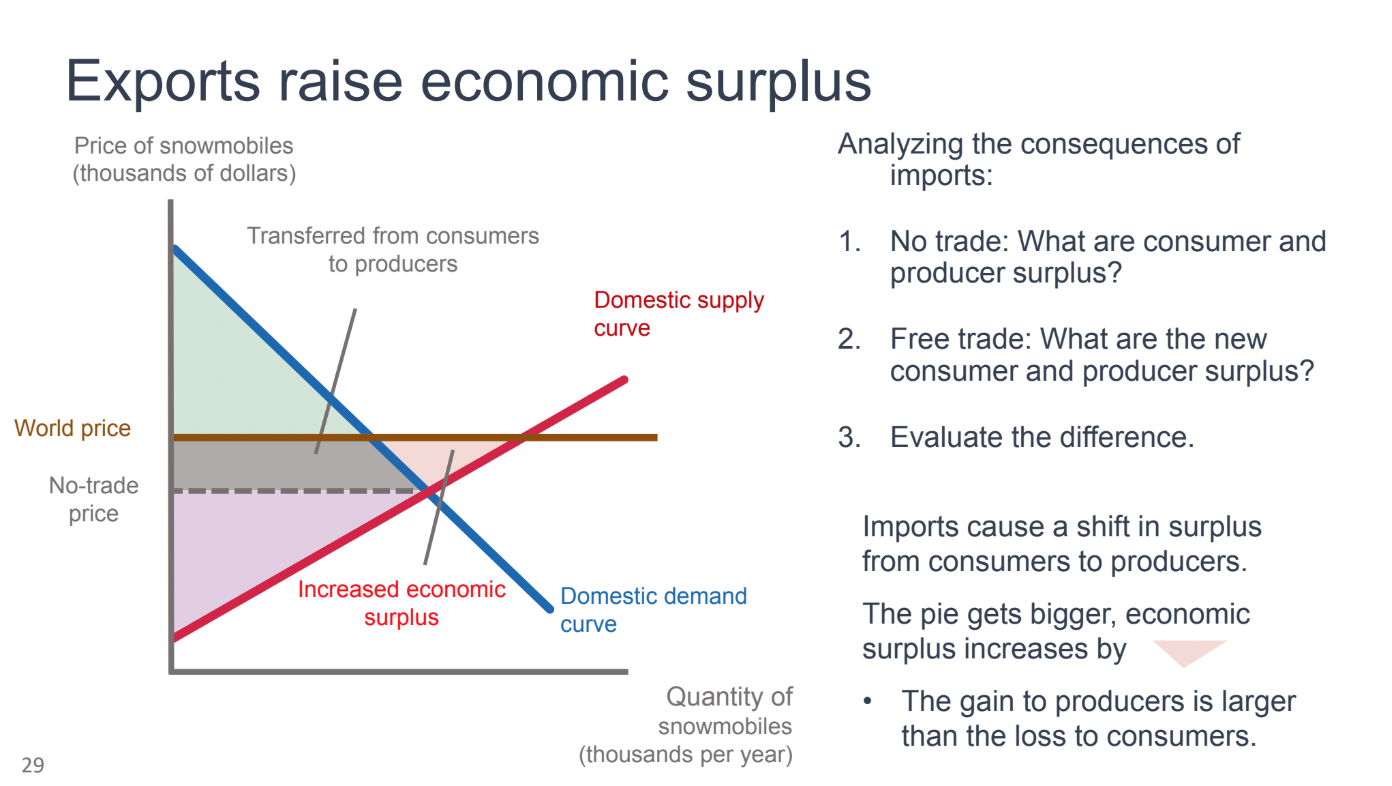
Consequences of trade on Domestic price
Effects of Imports
decreases (to the world price)
Effects of Exports
Increases (to the world price)
The consequences of trade and the effects on Quantity supplied (domestically)
Effect of Imports
Decreases (since it follows that law of supply)
Effect of Exports
Increases (since it follows that law of supply)
The consequences of trade and the effects on Consumers surplus
Effect of Imports
Bigger gain
Effect of Exports
Smaller fall
The consequences of trade and the effects on Producer surplus
Effect of Imports
Smaller fall
Effect of Exports
Bigger gain
Economic surplus
Effect of Imports
Increase overall
Effect of Exports
Increase overall
Five arguments for International trade
National Security Concerns
Protection for Infant Industries
Unfair Competition and Dumping
Enforcing Minimum Standards
Restrict Trade to Save Domestic Jobs
Argument FOR National Security Concerns
National security requires that we produce strategically important goods ourselves.
Health and safety: Make our own masks and vaccines.
Food security: Produce our own supply of certain food items.
National security: Develop our own weapons and security systems.
It may be critical to our health and safety that certain goods are produced in the country our trading partners cannot limit our access
Argument AGAINST National Security Concerns
Enemies rarely control the global market for any good. Even during the pandemic, food supply remained largely reliable.
As long as we are not cut off from all countries, we will have ways of getting what we need.
Argument FOR Protection for Infant Industries
Governments can help create new industries by shielding fledgling businesses from international competition.
Example: Brazil banned imports of computers to help Brazilian computer makers
Argument AGAINST Protection for Infant Industries
Infant industries often fail to grow as efficient as the competition.
Difficult for governments to identify which industries are likely to mature well protected.
Political pressure on governments to keep renewing the temporary protection
Argument FOR Unfair Competition and Dumping
Anti-dumping laws prevent unfair competition.
Dumping: Rival businesses temporarily charge extremely low prices, essentially dumping their good into the U.S. market.
Later, raise prices back up once their competition has been driven out of business
Counterargument Unfair Competition and Dumping
Difficult to distinguish “dumping” from an efficient producer.
Artificially low prices, or are low prices the result of a strong comparative advantage?
Truly able to produce at lower costs?
Argument FOR Enforcing Minimum Standards
Americans have agreed on certain minimum standards:
No child labor
Minimum wage
Safety and environmental standards
Trade can undermine these standards when we purchase foreign goods made in sweatshops (or with child labor, or in unsafe environments, etc.)
Counterargument for Enforcing Minimum Standards
Restricting trade with low-income countries will create even more poverty.
Working a low-paid job beats having no job
Argument FOR Restrict Trade to Save Domestic Jobs
Domestic workers employed in industries that compete with imported goods will lose their jobs.
Concerns that these workers will not be re-employed in another job
Counterargument Restrict Trade to Save Domestic Jobs
Restraining trade will destroy jobs in businesses that rely on imported inputs.
Example: U.S. restrictions on sugar imports preserve jobs in the domestic sugar industry, but...
The high price of sugar in the United States pushed candy manufacturing to other countries.
Trade causes export-oriented sectors to expand, creating new jobs.
Trade changes what workers do, not how many people work
How do your evaluate how international policies affect the market
Start by understanding the impact of tariffs!
Tariff: A tax on imported products.
Tariffs increase trade costs
How to evaluating the effects of an import tariff
Find the new price
Determine the quantities demanded and supplied by domestic buyers and sellers at this new price
Evaluate the quantity that will be traded
Step 1 to evaluating The effect of an important tariff
Find the new price
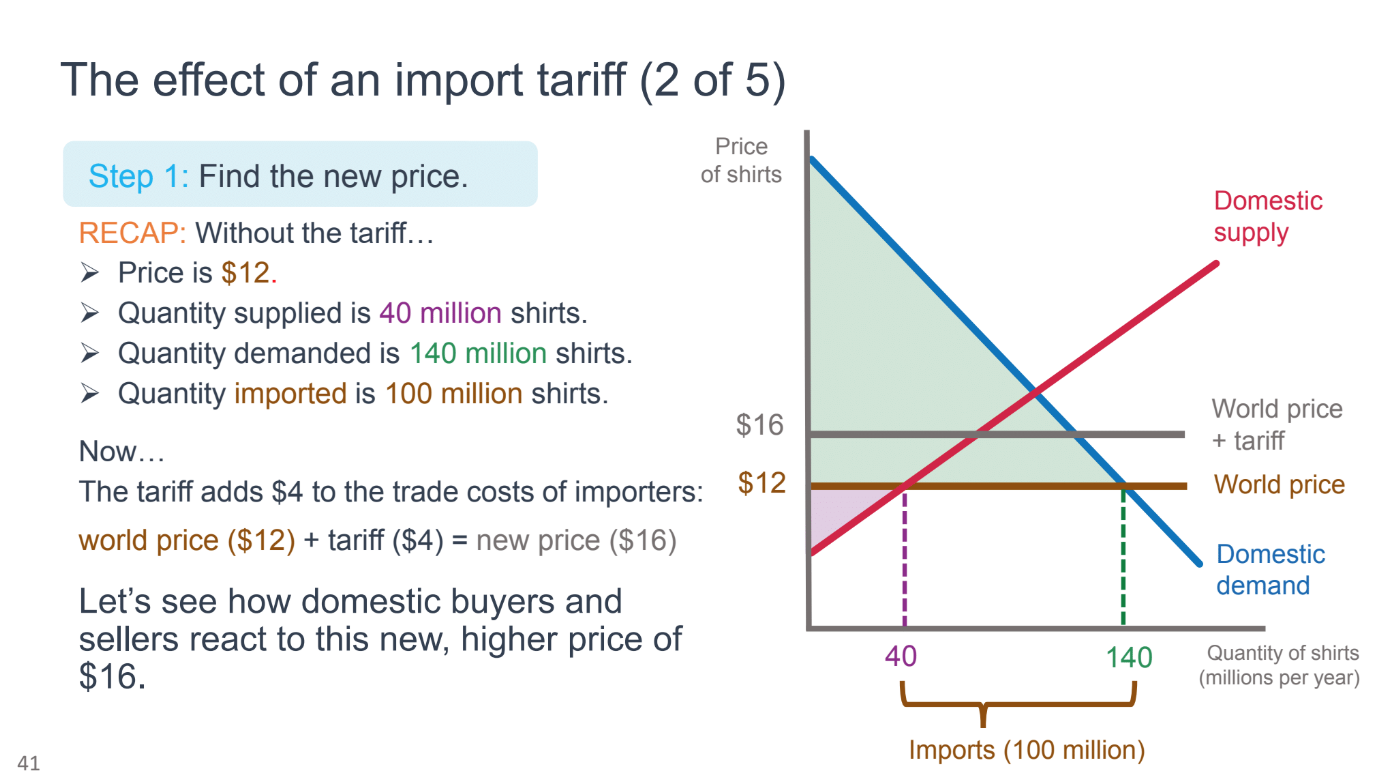
Step 2 to Evaluating the effect of an important tariff
Determine the quantities demanded and supplied by domestic buyers and sellers at this new price
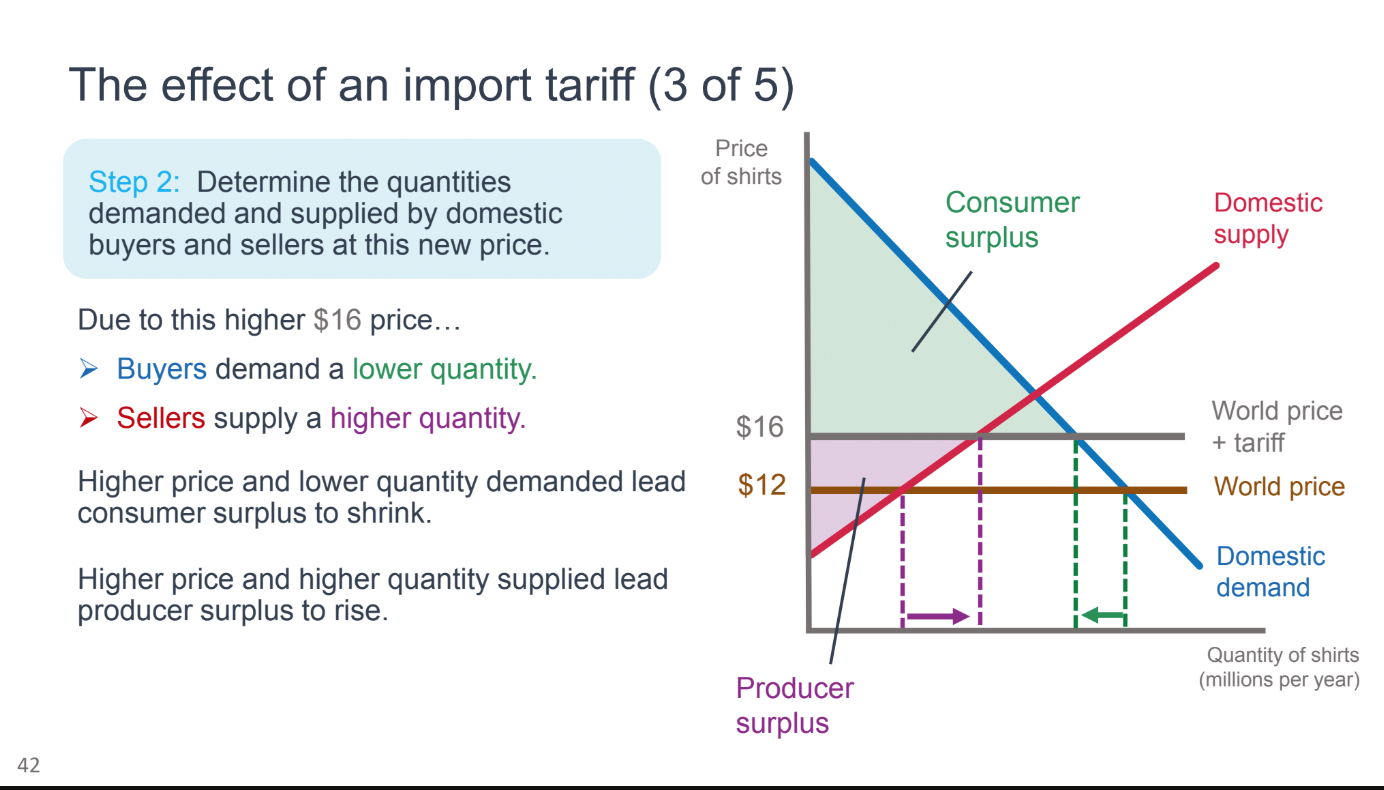
Step 3 to Evaluating the effect of an important tariff
Evaluate the quantity that will be traded

Tools of Trade Policy
Tariffs: Reduce international trade, and raise revenue for domestic government.
Red tape: Reduces international trade but does not raise revenue for the domestic government.
Import quotas: Reduce international trade just as tariffs do (exact same price and quantity outcomes) but do not raise government revenue.
Import quota: A limit on the quantity of a good that can be imported.
Exchange rate manipulation: A country can use this tool to increase its exports and reduce its imports
Globalization
The increasing economic, political, and cultural integration of different countries
The Rise of Globalization
Declining trade costs are a driving force of globalization:
Lower trade barriers
Closer political integration
Improved telecommunications
Electronic banking
Internet
Improved rail, sea, and air transportation
RECALL the interdependence principle—your economic life depends on the decisions made by others, including people all around the world
Effect of Globalization on U.S. Wages
American and Chinese laborers don’t directly compete(different national labor markets)...
But their labor does compete in the form of the goods and services that are traded between countries
Productivity determines wages, and the productivity of U.S. workers is much higher than elsewhere
Effect of Globalization on Income Inequality in the United States
International trade likely may explain some of the rising income inequality in the United States
U.S. exports skill-intensive goods
U.S. imports low skill-intensive goods
U.S. exports skill-intensive goods
Lower trade costs...
Increase foreign demand for these goods...
which increases domestic demand for highly educated workers...
thus, raising the incomes of highly educated workers
U.S. imports low skill-intensive goods
Lower trade costs...
Increase U.S. demand for these goods...
which decreases domestic demand for these types of goods...
which decreases domestic demand for low-skilled workers...
thus, decreasing the wages of these lower-skilled workers.
The magnitude of this effect is estimated to be small, but it is an ongoing area of research